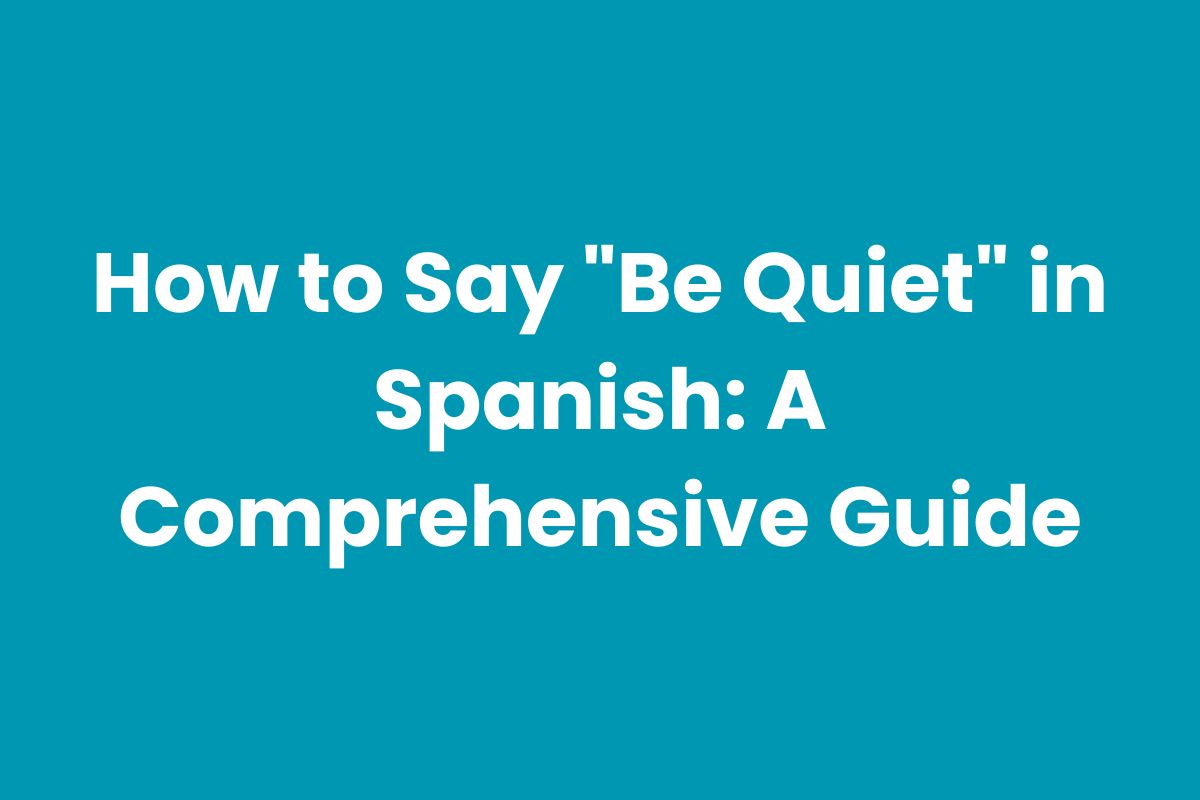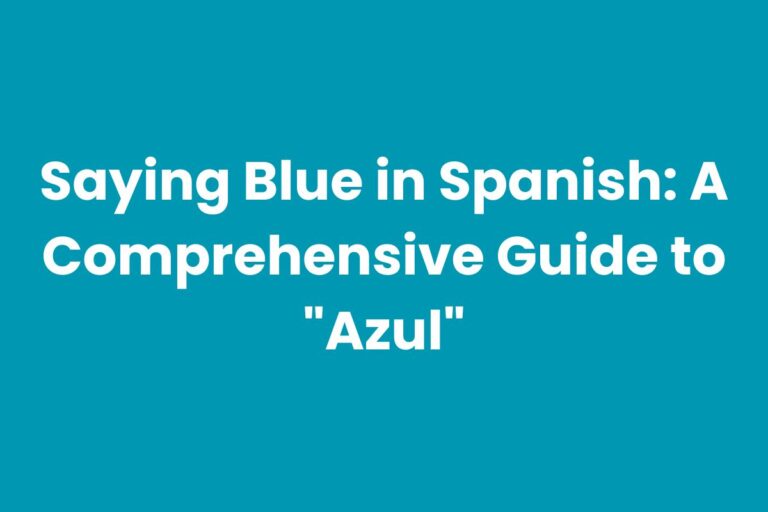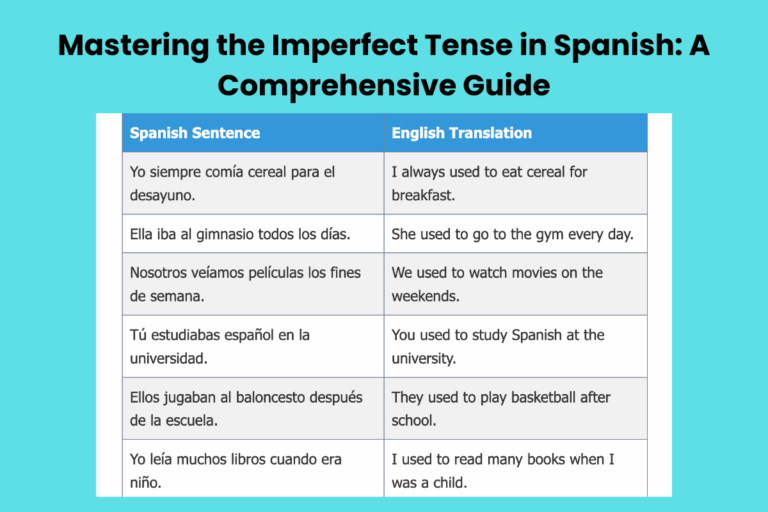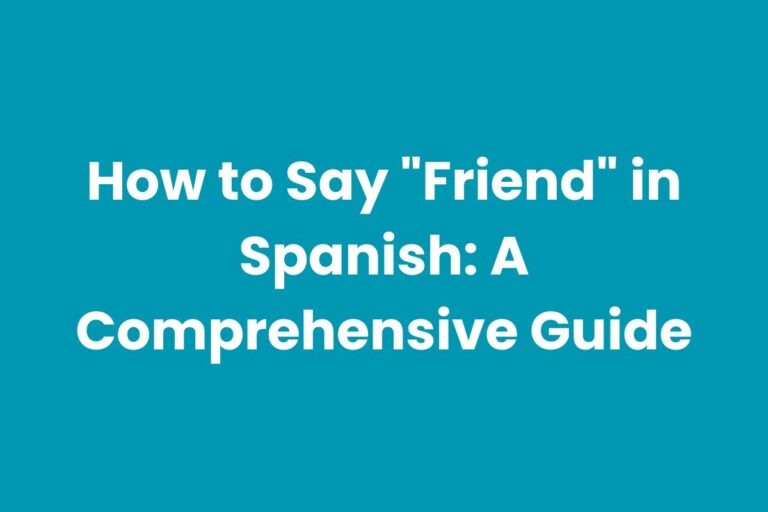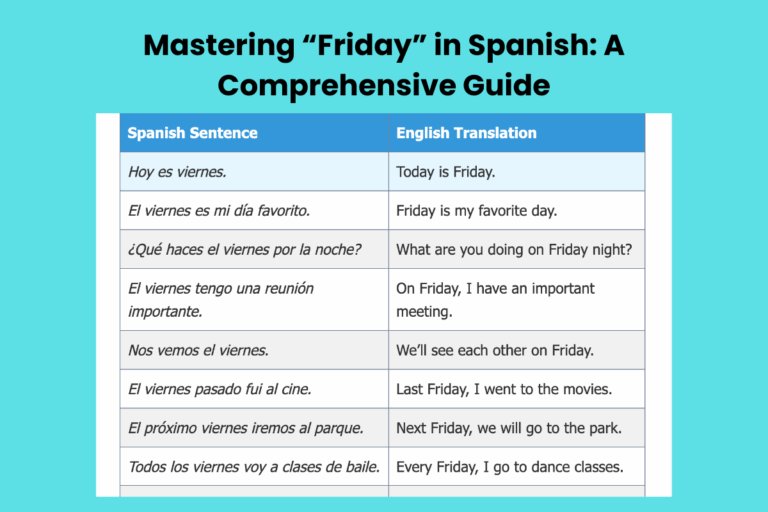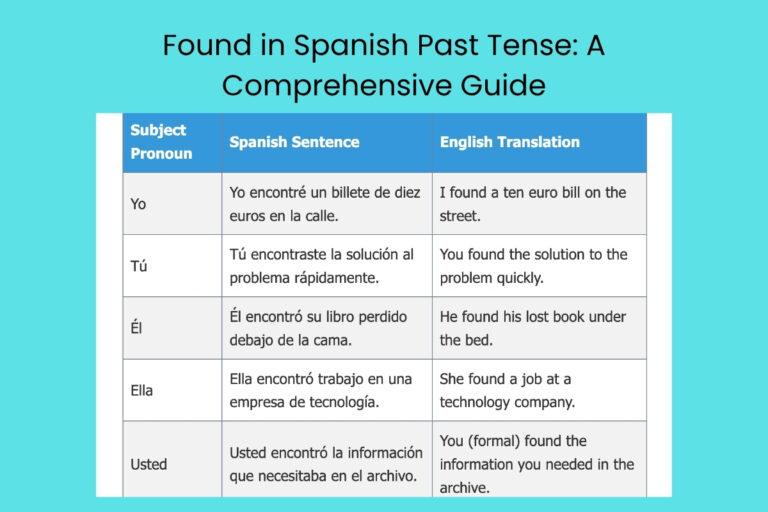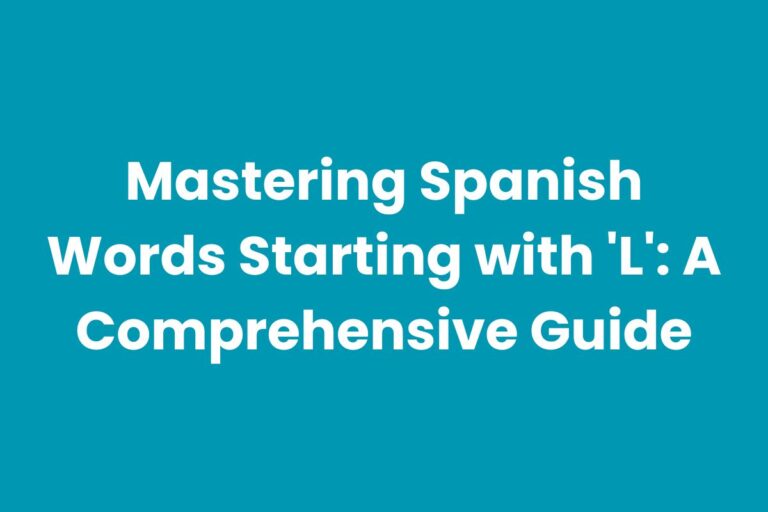How to Say “Be Quiet” in Spanish: A Comprehensive Guide
Learning how to say “be quiet” in Spanish is essential for effective communication in various settings, from classrooms to social gatherings. This seemingly simple phrase has multiple translations, each with its own nuance and level of formality.
Understanding these variations allows you to convey your message accurately and appropriately. This guide provides a comprehensive overview of the different ways to express “be quiet” in Spanish, along with explanations, examples, and practical exercises.
This article is perfect for students, travelers, and anyone interested in improving their Spanish communication skills.
Table of Contents
- Introduction
- Definition of “Be Quiet” in Spanish
- Structural Breakdown of Common Phrases
- Types and Categories of Expressions
- Examples of “Be Quiet” in Spanish
- Usage Rules and Considerations
- Common Mistakes to Avoid
- Practice Exercises
- Advanced Topics
- Frequently Asked Questions
- Conclusion
Definition of “Be Quiet” in Spanish
The phrase “be quiet” in Spanish encompasses various expressions used to request or demand silence. The specific translation depends on the context, the relationship between the speaker and the listener, and the level of formality required.
These expressions can range from direct commands to polite requests.
At its core, “be quiet” aims to reduce or eliminate noise. In Spanish, this can be achieved through imperative verbs, softer requests using conditional tenses, or even indirect suggestions that hint at the need for silence.
The chosen phrase often reflects the speaker’s authority or the social dynamics of the situation.
The function of these phrases is primarily to control the level of noise in a given environment. This could be in a classroom, a library, a meeting, or any situation where silence is desired or required.
The choice of expression can significantly impact how the message is received. A direct command might be effective in a noisy environment but could be perceived as rude in a more formal setting.
Therefore, understanding the nuances of each phrase is crucial for effective communication.
Structural Breakdown of Common Phrases
Several phrases translate to “be quiet” in Spanish, each with a unique grammatical structure. Let’s examine the most common ones:
- Cállate: This is the informal, imperative form directed at someone you address as tú. It’s a direct command using the reflexive pronoun te attached to the verb callar (to be quiet).
- Cállese: This is the formal, imperative form directed at someone you address as usted. The reflexive pronoun se is attached to the verb callar.
- Silencio: This translates directly to “silence.” While not a verb, it functions as a command or request for quiet.
- Guarda silencio: This phrase uses the verb guardar (to keep, to maintain) and means “keep silence.” It’s a slightly more polite way of asking for quiet.
- Por favor, silencio: This is the most polite way to ask for quiet, adding “please” (por favor) to the word “silence.”
The imperative forms (cállate, cállese) are created by conjugating the verb callar in the imperative mood. The placement of the reflexive pronoun (te, se) is crucial and always follows the verb in affirmative commands.
Types and Categories of Expressions
The ways to say “be quiet” in Spanish can be categorized based on their level of formality and directness:
Formal Commands
Formal commands are used when addressing someone you don’t know well, someone older than you, or someone in a position of authority. The formal command uses the usted form of the verb.
Informal Commands
Informal commands are used with people you know well, such as friends, family members, or children. The informal command uses the tú form of the verb.
Softer Requests
Softer requests are used when you want to be polite or avoid being confrontational. These often involve using phrases like “por favor” (please) or framing the request as a suggestion.
Indirect Suggestions
Indirect suggestions are used when you want to subtly indicate the need for quiet without directly commanding it. These can be useful in situations where a direct command might be inappropriate or ineffective.
Examples of “Be Quiet” in Spanish
Here are some examples of how to say “be quiet” in Spanish, categorized by formality and directness:
Formal Command Examples
The following table shows examples of formal commands to say “be quiet” in Spanish. These are typically used with people you don’t know well or those in a position of authority.
| Spanish | English Translation | Context |
|---|---|---|
| Cállese, por favor. | Be quiet, please. | Addressing a professor in a lecture hall. |
| Guarde silencio, por favor. | Keep silence, please. | Asking for quiet in a library. |
| Por favor, silencio. | Please, silence. | Addressing an audience before a presentation. |
| Señor, cállese. | Sir, be quiet. | Addressing a disruptive man in a meeting. |
| Señora, guarde silencio. | Madam, keep silence. | Asking a woman to be quiet in a theater. |
| Por favor, no hable. | Please, don’t talk. | Requesting silence during a test. |
| Les pido silencio, por favor. | I ask you for silence, please. | Addressing a formal gathering. |
| Podría guardar silencio, por favor? | Could you keep silence, please? | Asking a stranger politely to be quiet. |
| Le ruego que guarde silencio. | I beg you to keep silence. | A very formal and polite request for silence. |
| Silencio, por favor, estamos en una biblioteca. | Silence, please, we are in a library. | Reminding someone of the need for silence. |
| Guarde silencio, estamos en una reunión importante. | Keep silence, we are in an important meeting. | Emphasizing the importance of silence. |
| Cállese, esto es una falta de respeto. | Be quiet, this is disrespectful. | Expressing disapproval of the noise. |
| Señorita, por favor, silencio. | Miss, please, silence. | Addressing a young woman formally. |
| Por favor, silencio, el orador está hablando. | Please, silence, the speaker is talking. | Reminding people to respect the speaker. |
| Les ruego silencio durante la ceremonia. | I beg you for silence during the ceremony. | Requesting silence at a formal event. |
| Podría hacer el favor de guardar silencio? | Could you do the favor of keeping silence? | A very polite request. |
| Se requiere silencio en esta área. | Silence is required in this area. | Stating a rule or expectation. |
| Por favor, silencio, hay gente trabajando. | Please, silence, there are people working. | Explaining the reason for needing silence. |
| Le agradecería que guardara silencio. | I would appreciate it if you kept silence. | Expressing gratitude in advance. |
| Es necesario que guarde silencio durante la prueba. | It is necessary that you keep silence during the test. | Emphasizing the necessity of silence. |
Informal Command Examples
The following table shows examples of informal commands to say “be quiet” in Spanish. These are typically used with friends, family, or children.
| Spanish | English Translation | Context |
|---|---|---|
| Cállate. | Shut up. / Be quiet. | Telling a friend to be quiet. |
| Calla. | Quiet. | A shorter, more abrupt way to say “be quiet.” |
| Silencio. | Silence. | Telling children to be quiet. |
| Estate quieto. | Be still. / Be quiet. | Telling a child to be still and quiet. |
| No hables. | Don’t talk. | Asking a friend not to speak. |
| Chitón. | Shush. | A colloquial way to ask for silence. |
| A callar. | Be quiet. (Let’s be quiet.) | Encouraging a group to be quiet. |
| Calla un poco. | Be quiet a little. | Asking someone to be a bit quieter. |
| No digas nada. | Don’t say anything. | Requesting complete silence. |
| Cierra el pico. | Close your beak. (Shut your mouth.) | A very informal and sometimes rude way to say “be quiet.” |
| Baja la voz. | Lower your voice. | Asking someone to speak more quietly. |
| No hagas ruido. | Don’t make noise. | Asking someone not to make any noise. |
| Cállate ya. | Be quiet now. | Expressing impatience. |
| Silencio, porfa. | Silence, please (informal). | An informal way to ask for silence. |
| Shhh. | Shhh. | An international sound for silence. |
| Calla, que me interrumpes. | Be quiet, you’re interrupting me. | Explaining why you need silence. |
| Estate calladito. | Be very quiet. | Emphasizing the need for silence. |
| No seas ruidoso. | Don’t be noisy. | Asking someone not to be loud. |
| Cállate un ratito. | Be quiet for a little while. | Asking for temporary silence. |
| Ya, silencio. | Okay, silence. | Asserting the need for silence. |
| Un poco de silencio, por favor. | A little silence, please. | Asking for a small amount of quiet. |
| ¿Puedes callarte? | Can you be quiet? | Asking if someone is capable of being quiet. |
| Silencio, estoy concentrado. | Silence, I’m concentrating. | Explaining why you need silence. |
| No molestes. | Don’t bother/annoy. | Asking someone to stop being disruptive. |
| Cállate, que no oigo. | Be quiet, I can’t hear. | Explaining that the noise is interfering with hearing. |
Softer Request Examples
The following table shows examples of softer requests to say “be quiet” in Spanish. These are used to be polite and avoid being confrontational.
| Spanish | English Translation | Context |
|---|---|---|
| ¿Podrías hacer silencio, por favor? | Could you be quiet, please? | Politely asking someone to be quiet. |
| ¿Puedes guardar silencio un momento? | Can you keep silence for a moment? | Asking for temporary silence. |
| Por favor, un poco de silencio. | Please, a little silence. | Requesting a small amount of quiet. |
| ¿Te importaría guardar silencio? | Would you mind keeping silence? | A very polite way to ask for silence. |
| ¿Serías tan amable de guardar silencio? | Would you be so kind as to keep silence? | An extremely polite request. |
| Disculpa, ¿podrías bajar la voz? | Excuse me, could you lower your voice? | Asking someone to speak more quietly. |
| Perdona, pero necesito silencio para concentrarme. | Sorry, but I need silence to concentrate. | Explaining the need for silence. |
| Si no te importa, ¿podrías estar en silencio? | If you don’t mind, could you be quiet? | A polite and indirect request. |
| Tal vez podríamos estar un poco más callados. | Maybe we could be a little quieter. | Suggesting quiet without directly asking. |
| ¿Crees que podrías estar callado un rato? | Do you think you could be quiet for a while? | Asking if someone is capable of being quiet temporarily. |
| Sería genial si pudiéramos tener un poco de silencio. | It would be great if we could have a little silence. | Expressing a desire for silence indirectly. |
| ¿No crees que deberíamos estar más callados? | Don’t you think we should be quieter? | Suggesting quiet as a shared responsibility. |
| Quizás sería mejor si no habláramos ahora. | Perhaps it would be better if we didn’t talk now. | Suggesting silence as a better option. |
| ¿Podríamos intentar estar un poco más silenciosos? | Could we try to be a little quieter? | Asking for a collective effort to be quiet. |
| Si fueras tan amable de no hacer ruido… | If you would be so kind as not to make noise… | A very polite and indirect request. |
| Me vendría bien un poco de silencio. | A little silence would do me good. | Expressing a personal need for quiet. |
| Estaría muy agradecido si pudieras guardar silencio. | I would be very grateful if you could keep silence. | Expressing gratitude in advance for silence. |
| ¿Es posible que estemos un poco más callados? | Is it possible for us to be a little quieter? | Asking if quiet is achievable. |
| ¿Podríamos mantener el silencio, por favor? | Could we maintain silence, please? | Asking for sustained silence. |
| Preferiría que no hablaras ahora. | I would prefer that you didn’t talk now. | Expressing a preference for silence. |
| ¿Te molestaría si te pido que guardes silencio? | Would it bother you if I asked you to keep silence? | Asking permission to request silence. |
| Necesito un poco de silencio para trabajar. | I need a little silence to work. | Stating a need for silence to justify the request. |
| ¿Podrías evitar hacer ruido, por favor? | Could you avoid making noise, please? | Asking someone to refrain from making noise. |
| ¿Qué te parece si estamos callados un rato? | What do you think if we are quiet for a while? | Suggesting quiet as a mutual agreement. |
Indirect Suggestion Examples
The following table shows examples of indirect suggestions to say “be quiet” in Spanish. These are used to subtly indicate the need for quiet.
| Spanish | English Translation | Context |
|---|---|---|
| Hay gente tratando de concentrarse. | There are people trying to concentrate. | Hinting that noise is disruptive. |
| ¿No oyes el concierto? | Don’t you hear the concert? | Suggesting that listening requires silence. |
| Es hora de dormir. | It’s time to sleep. | Suggesting that it should be quiet because it’s bedtime. |
| El bebé está durmiendo. | The baby is sleeping. | Explaining why silence is needed. |
| Estamos en una biblioteca. | We are in a library. | Reminding someone of the expected behavior in a library. |
| ¿Sabes que hay una reunión importante? | Do you know there’s an important meeting? | Implying that silence is expected during the meeting. |
| ¿No te parece que hay mucho ruido? | Don’t you think there’s too much noise? | Indirectly pointing out the excessive noise. |
| Esto requiere mucha concentración. | This requires a lot of concentration. | Suggesting that silence is necessary for concentration. |
| Creo que deberíamos bajar la voz. | I think we should lower our voices. | Suggesting a collective effort to be quieter. |
| Parece que hay alguien estudiando. | It seems like someone is studying. | Hinting that quiet is needed for studying. |
| Es mejor estar callados ahora. | It’s better to be quiet now. | Suggesting that silence is the preferred option. |
| Aquí se necesita silencio. | Silence is needed here. | Stating the need for silence without directing it at anyone specific. |
| ¿No deberíamos ser más considerados? | Shouldn’t we be more considerate? | Suggesting that being quiet is a form of consideration. |
| ¿Te das cuenta del ruido que estás haciendo? | Do you realize the noise you’re making? | Indirectly pointing out the person’s noise level. |
| Es importante mantener la calma aquí. | It’s important to keep calm here. | Suggesting that quiet is part of maintaining calm. |
| Hay que respetar a los demás. | We have to respect others. | Implying that being quiet is a sign of respect. |
| No quiero molestar a nadie. | I don’t want to bother anyone. | Suggesting that noise could be bothersome. |
| ¿No te parece que estamos hablando muy alto? | Don’t you think we’re talking too loud? | Indirectly pointing out the volume of the conversation. |
| Es un lugar para reflexionar. | It’s a place for reflection. | Suggesting that the environment is meant for quiet contemplation. |
| Necesitamos un ambiente tranquilo. | We need a quiet environment. | Stating the need for a quiet atmosphere. |
Usage Rules and Considerations
Using the correct form of “be quiet” in Spanish depends on several factors, including formality, context, and regional variations.
Conjugation Rules
When using imperative forms, remember the conjugation rules for tú and usted. The tú form is generally the same as the third-person singular of the present indicative, but with the “s” removed (e.g., hablas becomes habla). For reflexive verbs like callar, the pronoun te is attached to the end of the verb (e.g., cállate). The usted form is derived from the subjunctive mood.
Pronoun Placement
In affirmative commands, reflexive pronouns like te and se are attached to the end of the verb. In negative commands, they precede the verb (e.g., No te calles – Don’t be quiet). This is a crucial distinction to remember.
Regional Variations
While the core phrases for “be quiet” are generally understood across the Spanish-speaking world, some regional variations exist. For example, in some regions, you might hear alternative expressions or slightly different pronunciations.
Being aware of these variations can help you better understand and communicate with native speakers from different areas.
Common Mistakes to Avoid
Here are some common mistakes to avoid when telling someone to “be quiet” in Spanish:
| Incorrect | Correct | Explanation |
|---|---|---|
| Callarse. | Cállate / Cállese. | Callarse is the infinitive form. Use the imperative form (cállate for informal, cállese for formal). |
| No cállate. | No te calles. | In negative commands, the reflexive pronoun precedes the verb. |
| Silencio, por favor tú. | Silencio, por favor. | The pronoun tú is unnecessary and incorrect in this context. |
| Guardar silencio, Juan. | Guarda silencio, Juan. | Using the infinitive instead of the imperative form. |
| Cállate usted. | Cállese. | The pronoun usted is not used with the verb in this way. The conjugation of the verb already indicates formality. |
Practice Exercises
Test your understanding with these practice exercises:
- Translate: “Be quiet (informal).”
- Translate: “Be quiet (formal).”
- Translate: “Please be quiet.” (polite request)
- How would you politely ask a stranger to be quiet in a library?
- How would you tell a child to be quiet?
- Rewrite the following sentence using a more formal command: “Cállate.”
- Rewrite the following sentence using a softer request: “Cállate.”
- Correct the following sentence: “No cállate.”
- In what situation would you use “Chitón”?
- Translate: “There are people trying to concentrate.” (indirect suggestion)
Answer Key:
- Cállate.
- Cállese.
- Por favor, silencio. / ¿Podrías hacer silencio, por favor?
- Disculpe, ¿podría guardar silencio, por favor?
- Silencio. / Estate quieto.
- Cállese, por favor.
- ¿Podrías hacer silencio, por favor?
- No te calles.
- In an informal situation to quickly and quietly ask for silence (similar to “shush”).
- Hay gente tratando de concentrarse.
More Practice Exercises:
| Question | Answer |
|---|---|
| Translate: “Keep silence, please.” (formal) | Guarde silencio, por favor. |
| Translate: “Don’t talk.” (informal) | No hables. |
| Which phrase is more polite: Cállate or ¿Podrías hacer silencio, por favor? | ¿Podrías hacer silencio, por favor? |
| In what situation would you use Cállese? | When addressing someone formally and needing them to be quiet. |
| Translate: “Silence, I’m concentrating.” (informal) | Silencio, estoy concentrado. |
| Rewrite the sentence using a more direct command: “¿Podrías guardar silencio un momento?” | Cállate un momento. |
| Translate: “It’s time to sleep.” (indirect suggestion) | Es hora de dormir. |
| Correct the following sentence: “No cállese usted.” | No se calle. |
| What is a colloquial way to ask for silence? | Chitón. |
| Translate: “We are in a library.” (indirect suggestion) | Estamos en una biblioteca. |
Advanced Topics
For advanced learners, understanding the nuances of the subjunctive mood and idiomatic expressions can further refine your ability to communicate effectively.
Subjunctive Mood in Requests
The subjunctive mood is often used in more formal and polite requests. For example, instead of saying Cállese, you might say Le pido que se calle (I ask that you be quiet). The subjunctive adds a layer of politeness and indirectness.
Idiomatic Expressions
Spanish, like any language, has idiomatic expressions related to silence. For example, estar como un ratón (to be like a mouse) means to be very quiet. Understanding these expressions can add color and depth to your communication.
Frequently Asked Questions
- What is the most polite way to say “be quiet” in Spanish?
The most polite ways are using phrases like ¿Podrías hacer silencio, por favor? or Por favor, un poco de silencio. These phrases use the conditional tense and “por favor” to soften the request.
- When should I use cállate vs. cállese?
Use cállate with people you know well (friends, family) and cállese with people you don’t know well or those in a position of authority (formal situations).
- Is calla rude?
Calla can be considered abrupt, but it’s not necessarily rude. Its perceived rudeness depends on the tone of voice and the context. It is less polite than silencio or using a more complete phrase like Cállate, por favor.
- How do I say “don’t be quiet” in Spanish?
You would say No te calles (informal) or No se calle (formal). Remember that in negative commands, the reflexive pronoun precedes the verb.
- What does chitón mean?
Chitón is a colloquial expression similar to “shush” in English. It’s an informal way to quickly and quietly ask for silence.
- How can I tell someone to lower their voice in Spanish?
You can say Baja la voz (informal) or Baje la voz (formal). Another option is ¿Podrías bajar la voz, por favor? (Could you lower your voice, please?).
- What is the difference between silencio and guardar silencio?
Silencio means “silence” and can function as a direct command. Guardar silencio means “to keep silence” and is a slightly more polite way of asking for quiet, as it uses a verb.
- How do I make a formal request for silence in a meeting?
You could say Les pido silencio, por favor (I ask you for silence, please) or Por favor, silencio, estamos en una reunión importante (Please, silence, we are in an important meeting).
- What are some indirect ways to suggest silence?
You can use phrases like Hay gente tratando de concentrarse (There are people trying to concentrate) or El bebé está durmiendo (The baby is sleeping).
- How do I say “be very quiet” in Spanish?
You can say Estate calladito, which emphasizes the need for silence. You could also say Mucho silencio, por favor.
Conclusion
Mastering the various ways to say “be quiet” in Spanish is a valuable skill for effective communication. This guide has provided a comprehensive overview of the different expressions, their levels of formality, and their appropriate contexts.
By understanding the nuances of each phrase, you can confidently and respectfully request silence in any situation.
Remember to consider your audience and the setting when choosing your words. Practice using these phrases in
, and you’ll become more comfortable and fluent in Spanish.
Keep exploring new expressions and refining your understanding of the language, and you’ll find yourself communicating more effectively and confidently.

